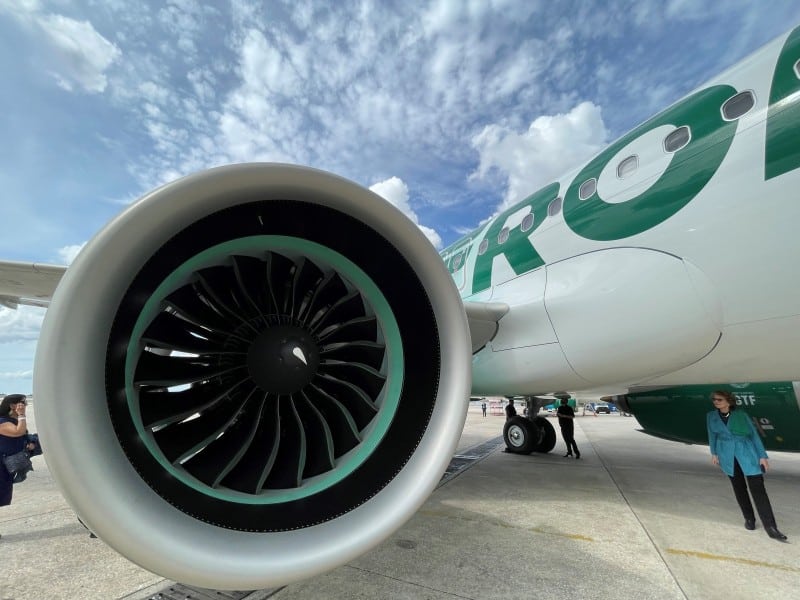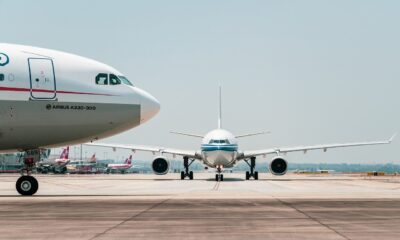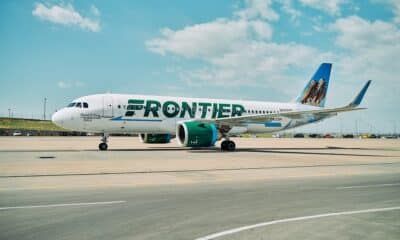Aerospace
Frontier Airlines Unveils New Ultra Fuel Efficient Airbus A321neo
#FrontierAirlines officially unveiled its first ultra-fuel-efficient #Airbus #A321neo aircraft at an event at Tampa International Airport.

Today, Frontier Airlines (Nasdaq: ULCC) officially unveiled its first ultra-fuel-efficient Airbus A321neo aircraft at an event at Tampa International Airport (TPA). The 240-seat A321neo, powered by Pratt & Whitney’s groundbreaking GTF engines, will be the most fuel-efficient commercial aircraft among any U.S. airline. Frontier’s A321neo will generate significantly lower carbon emissions and engine noise, furthering the efforts of America’s Greenest Airline to reduce its environmental footprint.
Frontier currently has 226 aircraft in total on order
The aircraft is the first of 158 A321neos to be delivered to the ultra-low-cost carrier by leading airplane manufacturer Airbus between now and 2029. Frontier currently has 226 aircraft in total on order which will nearly triple its fleet size by the end of the decade.
Airbus and partners embark on SAF deliveries in China(Opens in a new browser tab)
“The addition of these new A321neo’s to our fleet will make the greenest airline in the U.S. even greener with these aircraft able to achieve 120 miles per gallon per seat,” said Barry Biffle, president, and CEO, of Frontier Airlines. “They are the most fuel-efficient aircraft in operation among major U.S. airlines and are capable of delivering immediate, tangible reductions in fuel consumption, carbon emissions, and engine noise.
China’s top 3 airlines will purchase nearly 300 Airbus A320neo aircraft.(Opens in a new browser tab)
Frontier continues to lead the way in reducing fuel consumption and lessening our environmental footprint and the addition of the A321neo to our fleet is another step in that journey,” Biffle added.
Frontier Airlines Is Adding More New Nonstop Flights to Jamaica(Opens in a new browser tab)
The debut event in Tampa also included the unveiling of a highly striking special-edition aircraft livery, along with the animal featured on the aircraft’s tail – Frederick the Bald Eagle, inspired by Pratt & Whitney and named for its founder Frederick B. Rentschler. Rentschler was a trailblazer in aviation, designing engines that were dramatically lighter and more fuel efficient than their predecessors. All Frontier aircraft feature an animal on their tail, many of them endangered and threatened species.

“Frederick Rentschler transformed aviation with the most efficient, dependable engines of their time. Our employees, who voted to name this plane in his honor, carry on his vision with new technologies like the revolutionary geared fan at the heart of our GTF engines,” said Rick Deurloo, president of Commercial Engines at Pratt & Whitney.
Lowest greenhouse gas emissions for the Airbus A320neo family.
“With up to 20 percent in savings, GTF engines are the most fuel-efficient with the lowest greenhouse gas emissions for the Airbus A320neo family. These GTF-powered aircraft fly more passengers, farther, more sustainably, and with lower operating costs — helping Frontier add new routes and keep fares low.”

“Frontier has the largest A321neo backlog in North America — a concrete example of their core focus on efficiency and the environment,” said Jeff Knittel, chairman, and CEO of Airbus Americas. “With its lower fuel burn, emissions, and noise footprint, the A321neo will fly Frontier deep into the ‘green’ future, pleasing passengers while concentrating on sustainability, priorities we at Airbus admire and share.”
The unveiling event took place at the Airborne Maintenance and Engineering Services facility at TPA. Frontier operates a crew base at TPA and is the airport’s third-largest carrier based on destinations served. The event included a large contingent of team members from Frontier, Airbus, Pratt & Whitney, and TPA who gathered to celebrate the special milestone.


Aerospace
Which is bigger 777x or 787 aircraft ?

The 777X is a new series of the Boeing 777 family and is designed to be larger and more efficient than its predecessor. It features two variants: the 777-8 and the 777-9, being the larger of the two.
The Boeing 777X emerges as the larger sibling within the Boeing family, representing a significant leap forward in both size and efficiency. Comprising two variants, the 777-8 and the 777-9, the latter takes the crown as the larger of the two. With its expansive fuselage and impressive wingspan, the 777X is tailored for long-range journeys and boasts a substantial passenger capacity.
On the other hand, the Boeing 787, affectionately known as the Dreamliner, occupies a niche in the market as a smaller yet formidable aircraft designed for medium to long-range flights. Its distinguishing feature lies in its composite fuselage, a technological marvel that renders it lighter and more fuel-efficient compared to conventional aluminum counterparts. The Boeing 777X is larger than the Boeing 787 aircraft.
When it comes to passenger capacity, the 777-9 reigns supreme, typically accommodating a sizeable contingent of 400-425 passengers in its standard configuration. In contrast, the 787, with its more modest dimensions, typically carries between 240-290 passengers, depending on the variant and layout.
One of the remarkable innovations introduced with the 777X is its folding wingtips, a feature designed to address the logistical challenges of accommodating such a large aircraft in conventional airport gates. These folding wingtips enable the 777X to retract its wings, allowing it to fit into gates designed for smaller aircraft while still reaping the benefits of an extended wingspan during flight, thereby enhancing fuel efficiency and operational flexibility
Aerospace
China Secures Production Certificate for Mass Production of Pilotless eVTOL Aircraft

The first passenger-carrying pilotless electric vertical takeoff and landing (eVTOL) aircraft in the world, the EH216-S, has received the Production Certificate for its eVTOL aircraft from the Civil Aviation Administration of China (CAAC).
This is a significant milestone for EHang Holdings Limited, the leading UAM technology platform company in the world. This outstanding accomplishment is another big step towards mass manufacturing for the eVTOL aircraft and the ensuing commercial operations, building on the ground-breaking acquisition of the Type Certificate and the Standard Airworthiness Certificate for the EH216-S.
The PC is a crucial certificate that the aircraft maker receives from the CAAC, the country’s aviation authority. By obtaining this certificate, EHang has demonstrated that it has set up a quality management system for mass production that satisfies the airworthiness regulation standards set forth by the CAAC, and the company has been given permission to continue producing mass quantities.
It is also a strong guarantee of the calibre of the goods made by EHang. Raw materials, supplier management, manufacturing organisation, production quality control, aircraft pre-delivery test, after-sales repair and maintenance, etc. are all included in the mass production quality management system for the EH216-S.
To ensure that every aircraft and its components that roll off the production line strictly adhere to the approved type design and safety requirements, the system sets clear guidelines and documentation for every step in the production procedure. This ensures comprehensive traceability and safety control.
Aerospace
Four Airbus A380 Superjumbos lined up to be scrapped

In a strategic move aimed at reclaiming valuable resources from the iconic Airbus A380 aircraft, VAS Aero Services and Dr. Peters Group have announced a significant collaboration.
This partnership marks a milestone in aviation logistics and aftermarket services, with four of these colossal planes slated for teardown and redistribution of used serviceable material (USM).
The venture between VAS Aero Services, renowned for its expertise in aircraft dismantlement, and Dr. Peters Group, a prominent Germany-based investment fund management firm, underscores a commitment to sustainable aviation practices. This isn’t their first foray into scrapping A380s; their successful partnership has already seen the dismantlement of these aircraft, making them pioneers in this niche.
Under the agreement, the latest consignment brings the tally to eight A380s entrusted to VAS by Dr. Peters Group. Managing Director Christian Mailly of Dr. Peters Group emphasized the trust placed in VAS, citing their unparalleled capabilities in dismantlement and aftermarket sales network. It’s a strategic move in response to the growing demand for quality USM parts, particularly with the resurgence in reliance on the A380.
Notably, the teardown process will be carried out at various locations, optimizing the positioning of harvested parts to cater to different markets. While some parts will be positioned in Europe to support operators in the region and the Middle East, others will remain in the Asia-Pacific region. This meticulous strategy ensures efficient access to spare parts, benefiting MROs and airlines across these markets.
The decision to retire these A380s comes at a time when operators are reassessing fleet strategies amidst evolving market dynamics. Despite initial plans for quick retirement due to the emergence of more fuel-efficient alternatives, factors such as a rebound in long-haul demand and delays in new widebody deliveries have prompted operators to reconsider. The A380, with its unique capacity and capabilities, presents a practical solution for short-term capacity management.


























